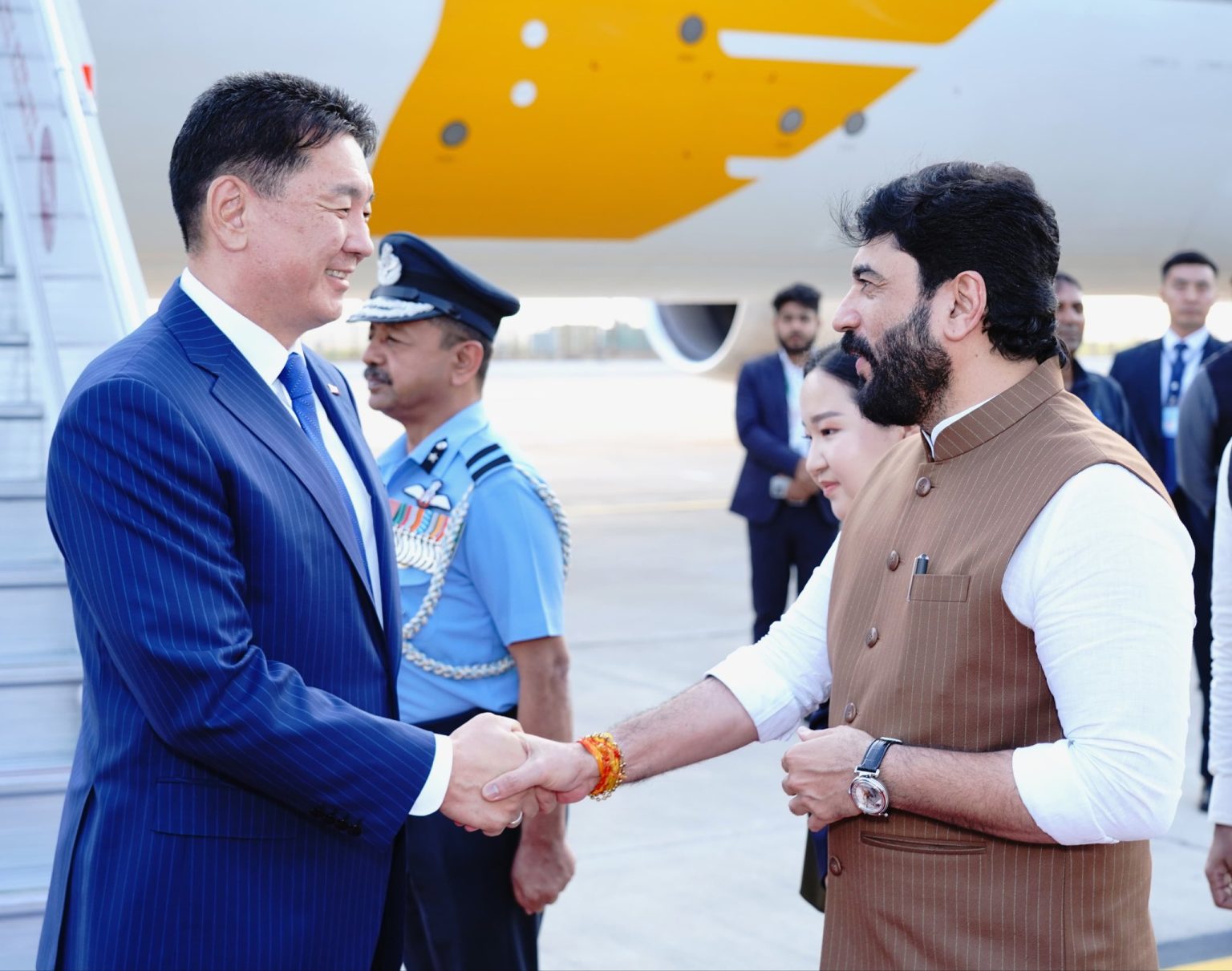President of Mongolia Khurelsukh Ukhnaa Arrives in New Delhi for Four-Day Visit

President of Mongolia Khurelsukh Ukhnaa’s Visit to India
Introduction
The President of Mongolia, Khurelsukh Ukhnaa, arrived in New Delhi on a four-day State Visit to India, marking his first official visit as President. He was received by Union Minister of State for Civil Aviation, Murlidhar Mohol, and accorded a ceremonial guard of honour.The visit underscores the growing strategic partnership between India and Mongolia, deeply rooted in shared civilizational values, democratic traditions, and mutual geopolitical interests.
I. Highlights of the Visit
- Duration: Four days (October 2025)
- Accompanying Delegation: Cabinet Ministers, Members of Parliament, senior officials, business leaders, and cultural representatives from Mongolia.
- Key Engagements:
- Bilateral Talks: Scheduled with Prime Minister Narendra Modi to review the full spectrum of relations and sign several MoUs.
- Meeting with President Droupadi Murmu: To be followed by a State Banquet at Rashtrapati Bhavan.
- Sectoral Engagements: Meetings with Indian business and cultural communities to enhance economic and people-to-people cooperation.
II. Historical Context of India–Mongolia Relations
- Diplomatic Relations Established: 1955
- Treaty of Friendly Relations and Cooperation: 1994
- Strategic Partnership: Declared in 2015 during the visit of Prime Minister Narendra Modi to Mongolia — the first-ever visit by an Indian Prime Minister to the country.
The bilateral relationship is anchored in:
- Cultural and Spiritual Linkages: Rooted in Buddhism, which forms a strong civilizational bond.
- Democratic Values: Both nations share similar political systems and outlooks on governance.
- Third Neighbour Policy: Mongolia’s foreign policy concept where India is viewed as a vital partner beyond its immediate neighbours, Russia and China.
III. Areas of Cooperation
1. Political and Strategic Partnership
- Regular high-level visits and dialogues at ministerial and parliamentary levels.
- Convergence on regional and global issues such as Indo-Pacific stability, counterterrorism, and climate change.
- Cooperation under frameworks such as the United Nations, ASEM (Asia-Europe Meeting), and NAM (Non-Aligned Movement).
2. Defence and Security Cooperation
- Joint defence training and military exercises under the “Nomadic Elephant” series.
- Collaboration in capacity building and defence education.
- India’s assistance in strengthening Mongolia’s peacekeeping capabilities under UN mandates.
3. Economic and Development Partnership
- India’s Line of Credit worth USD 1 billion for infrastructure and energy projects, including the Oil Refinery Project at Dornogobi, Mongolia’s first-ever oil refinery.
- Collaboration in mining, energy security, and renewable energy development.
- Cooperation in IT, pharmaceuticals, and healthcare, expanding opportunities for Mongolian students and professionals.
4. Cultural and Educational Ties
- Shared Buddhist heritage reflected through projects like the Restoration of Gandan Monastery and Buddhist cultural exchanges.
- Scholarships under the Indian Council for Cultural Relations (ICCR) and ITEC programmes.
- Growing popularity of Indian films, yoga, and Ayurveda in Mongolia, contributing to soft power diplomacy.
5. People-to-People and Parliamentary Exchanges
- Inter-parliamentary dialogues and youth exchanges to deepen democratic cooperation.
- Increasing tourism and religious pilgrimages to Buddhist sites such as Bodh Gaya and Sarnath.
IV. Strategic Significance of the Visit
- Balancing Regional Dynamics:
Mongolia, being landlocked between Russia and China, views India as a trusted strategic partner under its “Third Neighbour” policy. The visit enhances India’s influence in the Central and East Asian geopolitical space. - Energy and Economic Cooperation:
The operationalization of the India-assisted Oil Refinery Project will help Mongolia reduce its energy dependency on imports, strengthening energy security and economic diversification. - Cultural Diplomacy and Buddhist Linkages:
Buddhism serves as a bridge of mutual understanding, reinforcing India’s cultural leadership in Asia and complementing its Act East Policy. - Multilateral Collaboration:
Both sides are expected to reaffirm cooperation in multilateral platforms, focusing on UN reforms, sustainable development, and climate commitments. - Technology and Capacity Building:
The visit is likely to enhance cooperation in digital connectivity, e-governance, and skill development, aligning with India’s Digital Public Infrastructure model.
V. Expected Outcomes
- Signing of new MoUs in areas such as mining, renewable energy, education, healthcare, and cultural exchange.
- Review of progress on the Oil Refinery Project, symbolizing India’s largest development assistance initiative in Mongolia.
- Strengthening of defence cooperation and joint training programmes.
- Establishment of new institutional partnerships between universities and research bodies.
- Enhanced business-to-business and government-to-business dialogue, promoting trade diversification.
VI. Broader Context: India’s Engagement with East and Central Asia
The visit aligns with India’s broader regional strategies:
- Act East Policy: Enhancing connectivity and cooperation with East and Southeast Asian nations.
- Connect Central Asia Policy: Deepening historical, cultural, and strategic relations with the Central Asian region.
- Indo-Pacific Vision: Building resilient partnerships with like-minded democracies.
Mongolia, situated at the intersection of these regions, holds strategic importance in India’s vision for a free, open, and rules-based Asian order.
VII. Challenges and Opportunities
| Challenges | Policy Opportunities |
|---|---|
| Limited physical connectivity between India and Mongolia | Strengthening cooperation through multilateral corridors like Chabahar Port and INSTC |
| Economic dependency of Mongolia on China | Promoting diversified trade and Indian investment in Mongolia’s resource sector |
| Harsh climatic conditions affecting project implementation | Adoption of sustainable and resilient infrastructure models |
| Need for continuous people-to-people engagement | Expanding academic, cultural, and tourism linkages |
Conclusion
President Khurelsukh Ukhnaa’s visit marks a new chapter in India–Mongolia relations, reaffirming the strength of a partnership built on trust, shared heritage, and strategic convergence.The evolving cooperation—from the energy sector to cultural diplomacy—reflects both nations’ commitment to fostering a stable, multipolar, and cooperative Asian order. As two democracies bound by spiritual ties and common aspirations, India and Mongolia continue to exemplify how civilizational bonds can serve as the foundation for modern strategic engagement.
Updated - October 13, 2025 8:51 PM | News On Air